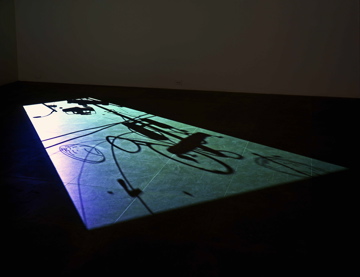Another exhibition of contemporary art to see this summer in Washington D.C. is The Cinema Effect Part II: Realisms through September 7, 2008 at the Hirshhorn. A two-part exhibition, the second installation focuses on realisms, exploring notions of fiction and reality and sometimes, the overlaps between the two (the first installation explored dreams). In Realisms, artists use video and film in a multitude of ways including combining existing footage, re-staging events or films, and using actors to create new works. The works also range from single monitors to wall-size projections, such as Matthew Buckingham’s projection through a two-way mirror and Paul Chan’s projection on the floor.
I was most interested in works by Candice Breitz and Mungo Thomson. Candice Breitz’s Mothers and Fathers edits excerpts from popular films of mothers in one room and fathers in a second room. Presented on multiple monitors, the characters’ dialogues and actions overlap in interesting and sometimes revealing ways while also exploring constructions of mothers and fathers in movies.
Mungo Thomson’s New York, New York, New York, New York seemingly presents video on four screens of New York streets. Close observation (or reading the label) allows one to learn these are not New York City streets but instead Hollywood sets of New York City. This difference between reality and fiction is one that some visitors will discover while others will miss.
Realisms also includes screenings of Jeremy Deller’s The Battle of Orgreave, a re-enactment of a 1984 miner’s strike whose participants included some of the miners, families, and townspeople who originally participated in the conflict. Kota Ezawa’s The Simpson Verdict, uses paper-cut animation of the OJ Simpson trial to present an alternate perspective of this heavily documented media event. Projected on the floor, Paul Chan’s 1st Light loops to present a sometimes empty sky that, as time passes, fills with falling debris from daily life.
While many museums have blogs, the Hirshhorn’s Ask the Artist Blog offers week-long opportunities to ask individual artists in The Cinema Effect questions about their work and practice. The Hirshhorn also offers a video preview of the exhibition and podcasts of related talks.
Video-based artwork offers challenges to visitors as well as museums in its display, but The Cinema Effect offers a successful reflection on this medium. As educators (logistical issues aside), some video and film works are easier to share with students than others. This past spring, we had many successful discussions about a video-based VOOM portrait by Robert Wilson on display at the museum where I work.
As an educator, have you discussed any video-based works of art by artists like Catherine Sullivan (Season 4), Mike Kelley (Season 3), Matthew Barney (Season 1) or others? What do you find challenging about discussing video art with your students?




